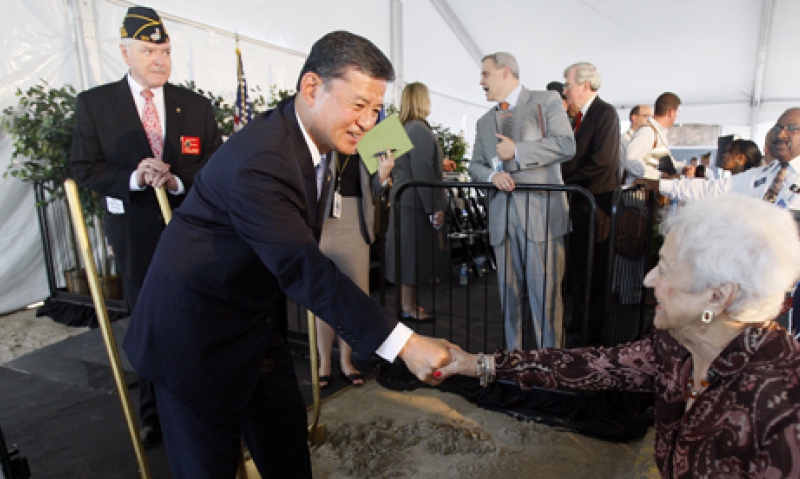
The spirit of a city
On June 25, the Department of Veterans Affairs broke ground on its 1.5-million square-foot medical center that will replace the one in New Orleans nearly destroyed during Hurricane Katrina.
American Legion Past National Commander William Detweiler, a New Orleans resident who led the Pledge of Allegiance during the ground-breaking ceremony, served on the advisory committee for the project's design team. Before the ceremony, Detweiler talked about what the project means to both the city of New Orleans and himself.
Q: After what happened with Katrina and the hospital, there had to be a point of demoralization. What does it feel like to see what's about to break ground here and what's going to be here for veterans in this area.
A: It's a very special day. It's a big day for the veterans of the southeastern portion of Louisiana. This hospital will serve a region of 23 parishes or counties as the main draw, but at the same time it's a regional hospital. There will be referrals and destination treatments for various types of injury, various types of diseases, to this hospital from across the South.
Q: The realization of needing a replacement hospital after Katrina hit pretty quickly, didn't it?
A: It's a situation where we started right after Katrina to try to decide what we could do. We had great cooperation from the Louisiana legislative delegation and from VA to start looking at what we could do to bring the hospital back. We knew we could not go back into (the old building), so the question was, "What do we do?" Fortunately, the city worked out a deal with VA and (Louisiana State University) - which is a teaching hospital here, along with Tulane University - to build these hospitals side by side. We're very fortunate that memorandum was signed almost immediately. Sen. (Mary) Landrieu was able to get in a supplemental bill, $630 million, to start us off. (VA Secretary Eric Shinseki) has been kind enough to add an additional $300 million or so to the bill, so we're not going to be stopped by looking for funds.
Q: Was it nice to see the collaboration between the different entities that made this possible?
A: It has been. The American Legion has been very supportive through this effort, through the magazine, through resolutions that were passed to urge Congress to rebuild here. They've been supportive of our efforts on the ground and in Congress with (House Committee on Veterans' Affairs Chairman Bob Filner). And Mr. Filner and the people on his staff have been very supportive of this effort.
Q: Is this hospital an example of the spirit of this city in coming back from Katrina?
A: No question. This hospital forms a very key part of the overall biomedical district that's being built at this time. We were on the verge of doing something similar before Katrina, but all the efforts were wiped out. Now we are moving along, and that effort is moving very quickly. We're building a new cancer center. We're building a new biosciences facility, and our two hospitals are up and running. Tulane and LSU continue to supply the residents to service our veterans and provide them with cutting-edge medicine.
This hospital is being built in such a way that it's going to be patient-friendly. We've done many focus groups, and those focus groups have been a key to the design of the hospital. We're building on that basis. There's a spine that runs through the entire hospital that will connect all of the various building - inpatient, outpatient, treatment facilities and so forth.
Q: A lot had to be considered when this hospital was being designed, didn't it?
A: I was on the advisory committee to the design team, and over a period of time that design was tweaked many times. There were times when the (Pan-American Building), which is being renovated into the administration building to placate some preservationist ... was going to be torn down. That's all been changed, and that's a result not only of input from the neighbors and from the preservationists, but from the veterans as well. This is a design that's going to be very veterans-friendly, and friendly to their families. In the case of a hurricane or something of that nature, a family could move in with the veteran. Those rooms are big enough. And we can double the capacity. We can go from 200 beds to 400 beds. It's all being built with all the new codes, as far as impact, national security - everything's being considered. So it's the first hospital being built at this time that has to follow all those new guidelines. This will be a state-of-the-art facility by the time it's all finished.
Q: Was there ever a time, maybe early on, when you thought, "I'm trying to see the light at the end of the tunnel, but I don't right now?"
A: It's been an uphill battle. New Orleans is known for its architecture. Preservationists really pride themselves on saving everything. A very close friend of mines heads the Preservation Resource Center here, and my position has always been, "You've got to give a little, and you've got to work with us." And for the most part, they are."
Q: What has been one of the important roles for you and other involved veterans in this facility's creation?
A: I'm just a volunteer. I can't even use this hospital. I'm not service connected in any way. But the important thing is, I think, is that the service I've rendered and a lot of veterans have rendered is that we're the cheerleaders. The VA people have gotten really depressed and down on occasion. It's tough. They've been slammed with all the various things from the preservationists and everything. We're the cheerleaders. We keep saying, "Let's be positive. Let's move along."
